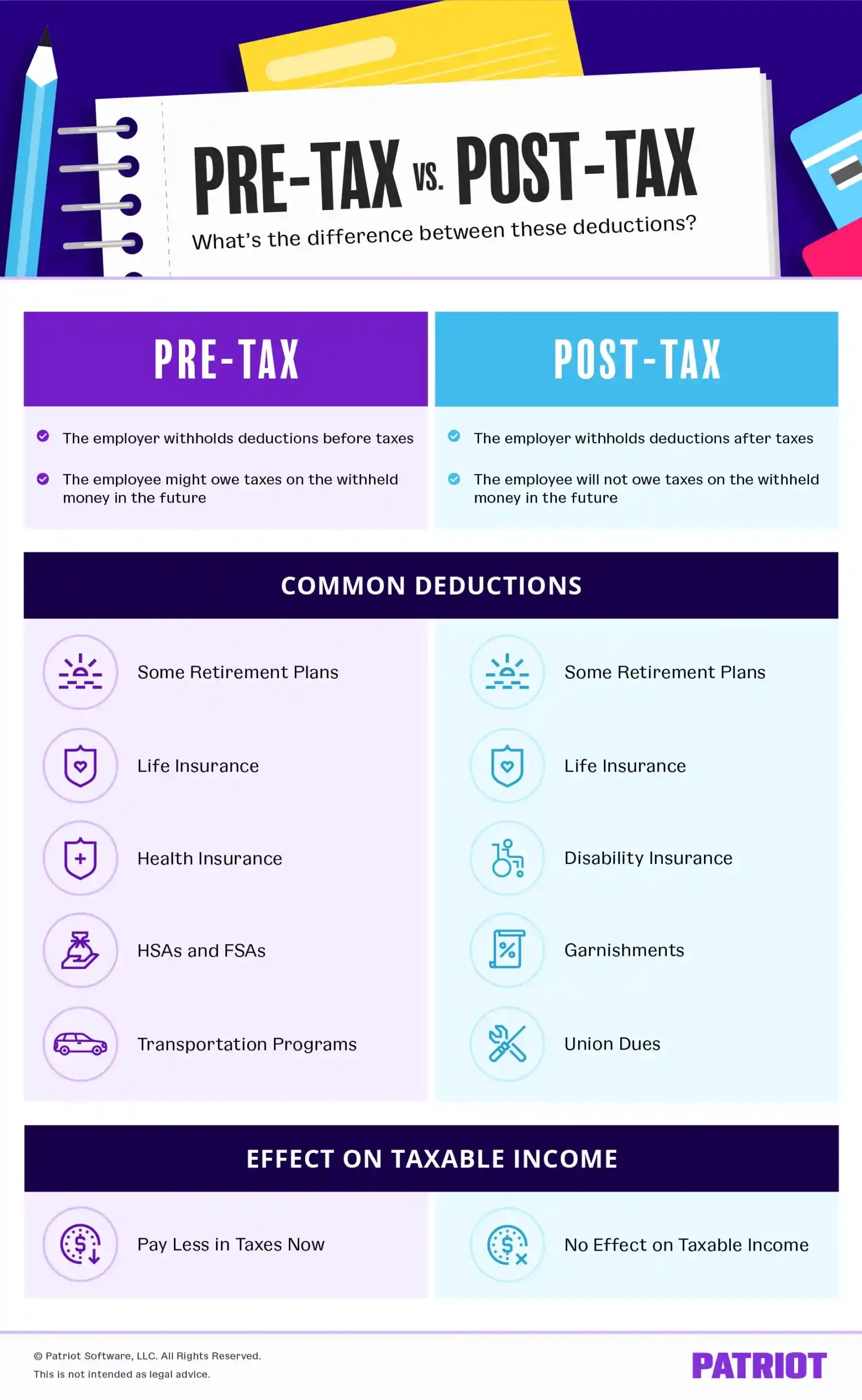If you provide benefits to employees, you probably wonder how to withhold wages for the benefits properly. Do you withhold the premiums and contributions before or after taxes? Can you choose to withhold however you want? Well, it depends on the benefit. So, you must understand the difference between pre-tax vs. post-tax deductions.
Pre-tax vs. post-tax deductions
You will withhold pre-tax deductions from employee wages before you withhold taxes. Pre-tax deductions reduce the amount of income that the employee has to pay taxes on.
You will withhold post-tax deductions from employee wages after you withhold taxes. Post-tax deductions have no effect on an employee’s taxable income.
Some benefits can be either pre-tax or post-tax, such as a pre-tax vs. post-tax 401(k) types. Often, the type of deduction you need to make is predefined in the policy for the benefit. Sometimes, you or the employee might have the option to choose whether or not a benefit has pre-tax vs. post-tax deductions.
Below is a breakdown of each type of deduction.

Pre-tax deductions
Remove pre-tax benefit deductions from employee pay before you deduct payroll taxes.
Pre-tax deductions offer the benefit of lower tax liabilities for both you and the employee. However, the employee might owe taxes in the future when they use the benefits. For example, an employee who retires will owe taxes when they withdraw money from a pre-tax 401(k) plan.
Also, not all pre-tax benefits are exempt from all federal tax withholdings. For example, adoption assistance is exempt from federal income tax withholding. But, adoption assistance is not exempt from Social Security and Medicare taxes, or FUTA tax.
Use Publication 15 and Publication 15-B to find out which pre-tax benefits are exempt from each federal employment tax.
Some pre-tax benefits may or may not be exempt from state and local taxes. Check your state and local laws to find out what benefit deductions are exempt from taxes.
Common pre-tax deductions
Common pre-tax deductions include:
- Some retirement plans (such as a 401(k) plan)
- Health insurance
- HSAs and FSAs
- Life insurance
- Transportation programs
You might need to withhold some of these deductions after taxes based on the policies your business has set up.
Pre-tax example
Let’s say your employee, Peter, earns $500 per week. Peter contributes 5% (0.05) per pay period to a pre-tax 401(k) plan.
When you begin payroll withholdings, you will first withhold the 401(k) contribution because it is pre-tax.
$500 X 0.05 = $25
You will withhold $25 from Peter’s wages and deposit the amount to his 401(k) account.
Now you need to calculate how much of each tax to withhold. The 401(k) contributions are exempt from federal income tax withholding, so you will not include the contribution when calculating income tax.
$500 – $25 = $475 (total wages taxable by federal income tax)
Based on IRS Publication 15-T, a single person who earns $475 and is paid weekly owes $19 in federal income tax (using the standard withholding amount).
The 401(k) contribution is taxable for Social Security and Medicare taxes.
$500 (total wages taxable by Social Security and Medicare taxes) X 0.062 (employee Social Security tax rate) = $31
Withhold $31 from Peter’s wages for the employee portion of the Social Security tax. You also need to pay the matching employer portion.
$500 X 0.0145 (employee Medicare tax rate) = $14.50
Withhold $14.50 from Peter’s wages for the employee portion of the Medicare tax. You also need to contribute the matching employer portion.
In the end, Peter’s take home pay is $410.50 ($500 – $25 – $19 – $31 – $14.50).
A deferral to a 401(k) account is taxable for federal unemployment tax (FUTA tax). This means the whole $500 is subject to FUTA tax. Only employers pay FUTA tax.
Post-tax deductions
You will subtract post-tax deductions from employee pay after you deduct payroll taxes.
You and your employee owe more payroll taxes with post-tax deductions. However, the employee won’t owe taxes on the benefits when using the benefits in the future. For example, an employee who retires will not owe additional taxes when they withdraw money from a post-tax retirement plan.
Because you withhold taxes before you withhold benefit contributions, all federal, state, and local taxes are already paid on the contributions.
Common post-tax deductions
Common post-tax deductions include:
- Some retirement plans (such as a Roth 401(k) plan)
- Disability insurance
- Life insurance
- Garnishments
You might need to withhold some of these deductions before taxes based on the policies your business has set up.
Post-tax example
Let’s say your employee, Carole, earns $500 per week. Carole contributes 5% (0.05) per pay period to a post-tax retirement plan.
You will first withhold any payroll taxes. The whole paycheck is subject to federal income tax withholding.
Based on Publication 15-T, a single person who earns $500 and is paid weekly owes $21 in federal income tax (using the standard withholding amount).
The whole paycheck is also subject to Social Security and Medicare taxes.
$500 (total wages taxable by Social Security and Medicare taxes) X 0.062 (employee Social Security tax rate) = $31
Withhold $31 from Carole’s wages for the employee portion of the Social Security tax. You also need to pay the matching employer portion.
$500 X 0.0145 (employee Medicare tax rate) = $14.50
Withhold $14.50 from Carole’s wages for the employee portion of the Medicare tax. You also need to contribute the matching employer portion.
After taxes, Carole’s wages amount to $433.50 ($500 – $21 – $31 – $14.50).
Now that you’ve withheld taxes, you can withhold the post-tax deduction for Carole’s retirement plan. Carole’s gross wages are subject to her contribution of 5%.
$500 X 0.05 = $25
You will withhold $25 from Carole’s wages for her retirement account.
In the end, Carole will take home $408.50 ($500 – $21 – $31 – $14.50 – $25).
A comparison
As you can see, Carole will pay more in taxes than Peter.
In this case, Peter has a greater net pay than Carole. An employee’s net pay will depend on their tax bracket and their total deductions.
Peter will owe taxes in the future on the money he uses from his retirement account. Carole will not owe taxes on her retirement account withdrawals in the future.
Make pre-tax and post-tax deductions easy by using Patriot Software’s online payroll software. We’ll accurately do the calculations for you, so you don’t have to worry about mistakes. Start your free trial today!
This article has been updated from its original publication date of March 15, 2017.
This is not intended as legal advice; for more information, please click here.






